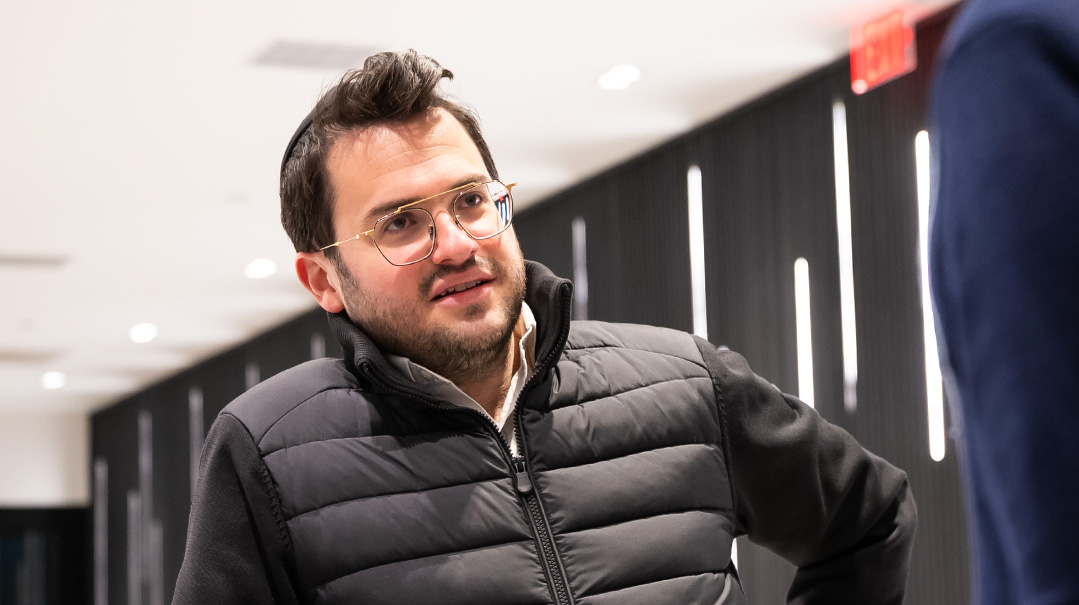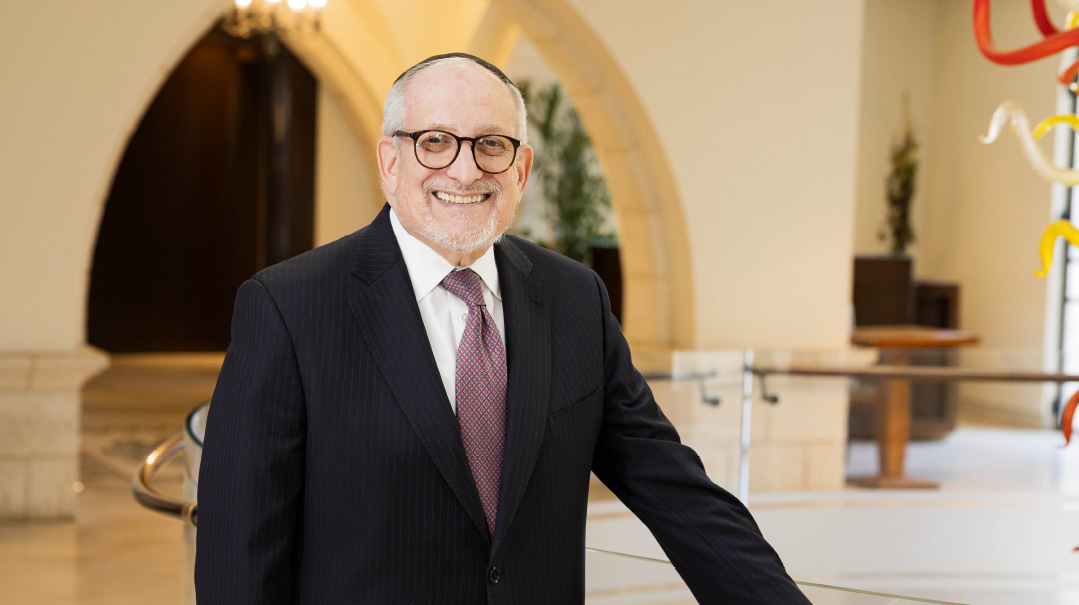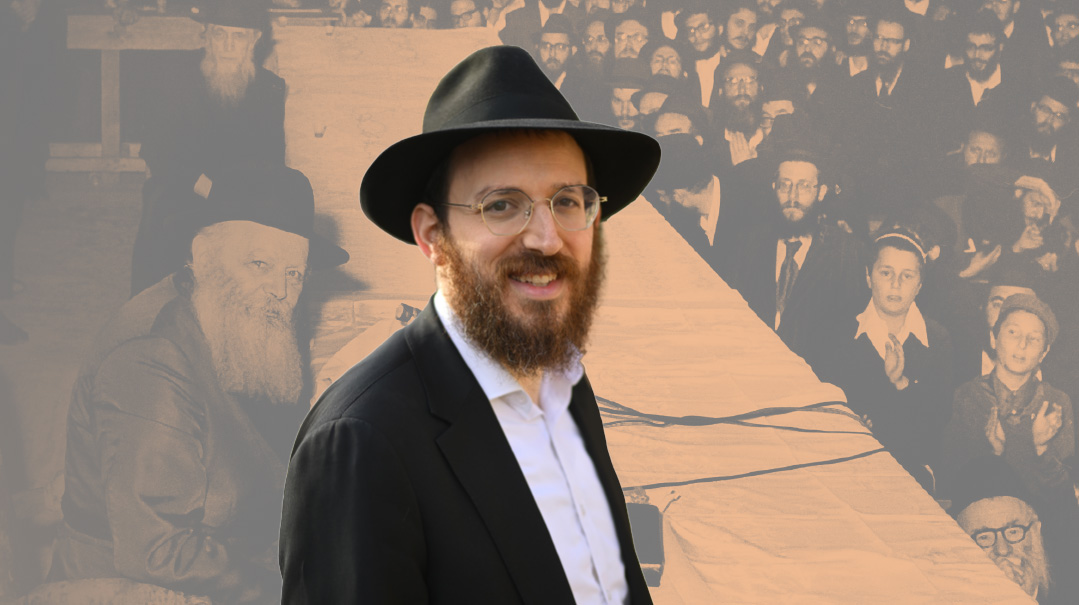For the Sake of a Nation
| June 4, 2024Reb Yidele of Dzikov walked among men but lived in the world of angels
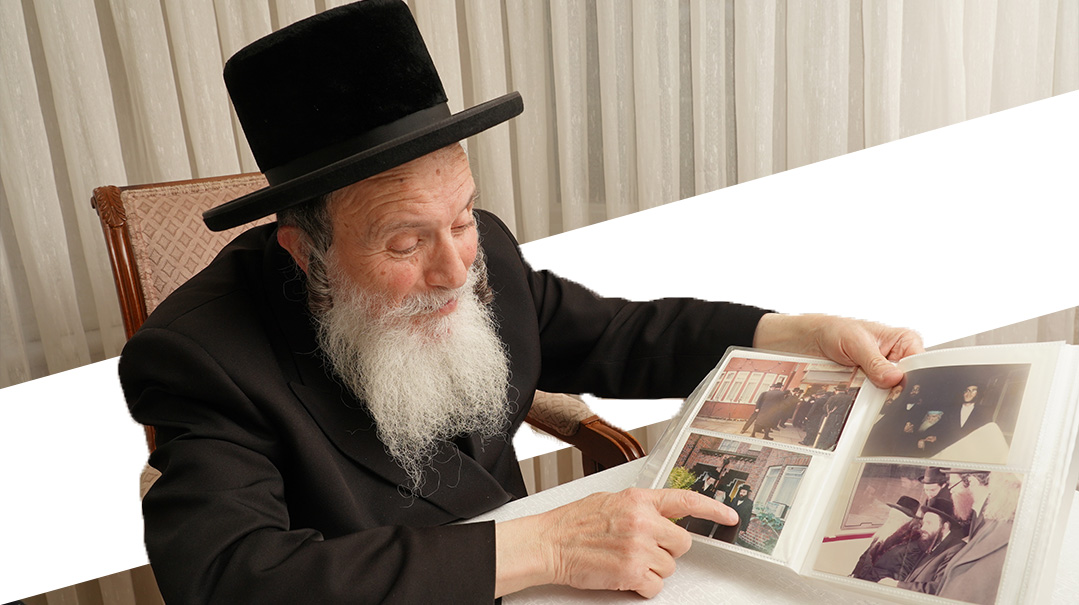
Photos: Mendel Photography
London-based rosh kollel and maggid shiur Rav Shloime Taussig is ever grateful for the years he spent at the side of Reb Yidele of Dzikov, a tzaddik who walked among men but lived in the world of angels. In Eretz Yisrael and toward the end of his life in England, Reb Yidele never agreed to “become a rebbe,” but he couldn’t hide the spiritual light that shined from his every move
There’s a scene that those fortunate to have been in Rav Yidele Horowitz’s inner circle will never forget: It’s Friday morning, and the saintly Reb Yidele, the only surviving son of the pre-war Dzikover Rebbe, is washing some items of clothing with soap and cold water. A white gartel. White socks. White yarmulke. White shal. Washed, wrung out, and hung on the railings of the small porch of his Jerusalem home, all the while chanting, “lekuved Shabbos kodesh, besheim kol Yisruel.” The simplest of actions, with the holiest of intent. And millions of such simple actions, minute by minute of “l'sheim mitzvah,” added up to a life lived with total self-effacement and incredible piety and purity.
During the postwar decades that he lived in Eretz Yisrael, Reb Yidele, who shunned publicity as well as the title of “rebbe,” was particular not to use his refrigerator on Shabbos because of certain halachic stringencies. On Thursday, he would prepare a bowl of water and freeze it in order to keep food cold on Shabbos. Then, on Friday, the plug of the refrigerator would come out, “lekuved Shabbos kodesh, besheim kol Yisruel.”
“You can’t imagine the avodah, and you can’t imagine the beauty,” says Rav Shloime Taussig, a London-based rosh kollel and maggid shiur who spent years at Reb Yidele’s side, both in Jerusalem and, in the last years of Reb Yidele’s life, in London. “Putting on his shtreimel, he invoked the kavanah of ‘malbush leShabbos besheim kol Yisruel.’ On every bite, and even on a hot cup of tea on Friday night, the Rebbe would pronounce ‘besheim kol Yisruel, vekuroosuh leShabbos oneg.’ He was actualizing an idea of the Noam Elimelech, that even if one’s physical being is tainted by sin that might prevent those mitzvos from being accepted, doing the mitzvah united with all other Yidden — ‘besheim kol Yisruel’ — is the remedy.
Even on weekdays, when the Rebbe sat down to eat his meal, he had avodas Hashem in mind: “Besheim kol Yisruel vehiskadashtem vehiyisem kedoshim.” There simply was nothing mundane, no separation between the physical and the spiritual.
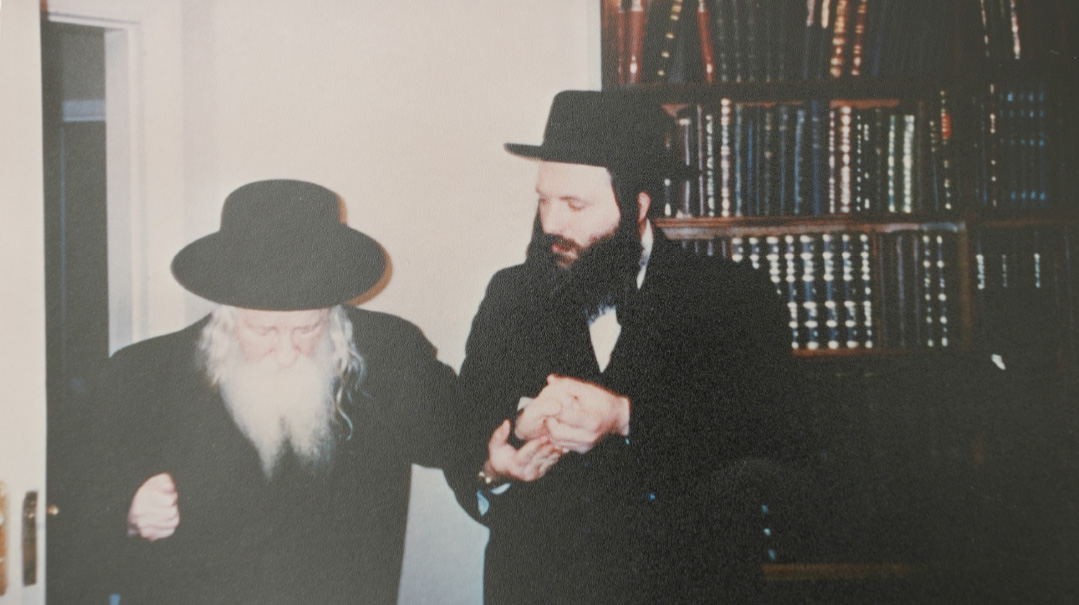
As a young avreich in Yerushalayim, Rav Shloime Taussig became Reb Yidele’s de facto gabbai. “I was with him 365 days a year. Everything was tefillos and avodah. Everything”
Hold On or Run
Rav Yidele Horowitz of Dzikov was born into “a Galicianer shtub” in the Polish shtetl of Dzikov in 1905, a son of Reb Alterel — Rav Alter Yechezkel Eliyahu of Dzikov — who was in turn the only son of the Ateres Yehoshua of Dzikov (1848-1912). Reb Yidele’s mother, Rebbetzin Chava, was the daughter of the Ahavas Yisrael, the third Viznitzer Rebbe.
He was an extremely gifted child, reputed to have the ‘kop,’ or learning faculties, of the Ropshitz and Dzikov dynasties that were in his blood. In later years, Reb Yidele once mentioned that he had learned all of Tanya by age six.
The family soon relocated to Tarnow. The town had no official yeshivah, but young Yidele sat in the beis medrash and learned at the feet of the gadol who lived there, Galicia’s famed luminary, Rav Meir Arik. A devoted student, he was present when the gedolim of Galicia came in to sit with Rav Meir and “talk in learning.”
“Reb Yidele told me that the Tchebiner Rav would visit, and so would Reb Moshenyu of Boyan (the Boyaner Rebbe of Krakow, known for his incredible scholarship), and whenever someone arrived, Rav Meir would ask him, the young talmid, to ‘bring in cake and bronfen.’ You have to understand that the learning was the whole day — there were no official hours of learning seder, and no lunch break,” Rav Taussig explains.
Rav Meir Arik had a special relationship with Reb Moshenyu of Boyan Hy”d. On one occasion, when the Boyaner Rebbe left to return to Krakow, Rav Meir walked him out, then told Reb Yidele to take the venerated guest to the train station. As Reb Yidele accompanied the Rebbe, the Rebbe suggested a deal to the bochur: “Bucher, zug mir vuss dein rebbe redt in lernen mit dir, un ich vell shreiben chiddushei Torah [You tell me what your rebbe speaks to you about in learning, and I will write chiddushei Torah back to you].” This deal resulted in Reb Yidele owning files of Reb Moshenyu’s handwritten chiddushim. They were lost during the war, much to Reb Yidele’s dismay. “If only I still had those writings…” he would say wistfully.
Reb Yidele was given semichah by Rav Meir Arik as well as the Minchas Elazar, Rav Chaim Elazar Shapiro of Munkacs.
After his marriage to a first cousin, Chana Miriam Sima, the daughter of his mother’s brother, the Imrei Chaim of Vizhnitz, Reb Yidele moved to Grosswardein, where his father-in-law lived, and where his grandfather the Ahavas Yisrael led the court of Vizhnitz, one of the largest chassidic courts in the region. (Grosswardein, or Nagyvárad or Várad in Hungarian, was transferred from Hungary to Romania following World War I.)
When in Grosswardein, Reb Yidele met Rav Yosef Naftoli Stern, a talmid and grandson-in-law of the Chasam Sofer, and discussed with him the importance of publishing the Chasam Sofer’s writings. Rav Stern agreed that the drashos of the Chasam Sofer, which he had edited, needed to be printed. When he told Reb Yidele that he did not have the money to undertake the project, Reb Yidele replied that he would raise the necessary funds — and donated his entire dowry, which he had received from the Imrei Chaim, for this holy purpose. He refused to have his name mentioned as sponsor, or even be hinted to as an anonymous donor. (When the Rebbetzin came to ask her father for money, the Imrei Chaim said, “Where is the naden that I gave to Yidele?” She responded, “He gave it away to publish the Chasam Sofer’s works.” (Much later, the Imrei Chaim commented that even though this hadn’t looked good at the time, the dowry his son-in-law had given away was all that remained from his pre-war assets.) Reb Yidele was very attached to the Chasam Sofer’s writings, often saying that the messages within the sefer spoke directly to his heart.
At age30, he moved to Klausenburg, where he was appointed as a dayan and became connected to the community. All the years of his life post-war, Reb Yidele kept 11 Sivan, the date of the deportation and murder of the Jews of Klausenburg, as a yahrtzeit for his townspeople. Over 40 years later, in 1989, he was eventually niftar on that very same date himself.
When war broke out, Reb Yidele and his rebbetzin left Klausenburg and went back to her father. Due to the dangers, Reb Yidele wanted to “‘hold on” and stay close to his father-in-law for spiritual protection, but the Imrei Chaim told him it was impossible to run away while holding on. The family split up and Reb Yidele and his wife began to run. They found shelter in Arad and Bucharest in Romania, and miraculously survived the war. In 1943, Reb Alterel of Dzikov was killed in Plaszow, near Krakow, leaving Reb Yidele as his only surviving son. (Reb Yidele’s two brothers, Rav Chaim Menachem David and Rav Meir, didn’t survive the Holocaust.)
In 1947, Reb Yidele and the Rebbetzin arrived in Eretz Yisrael, together with the Imrei Chaim. The Imrei Chaim decided to make the move after the Damesek Eliezer, the Imrei Chaim’s brother in Eretz Yisrael, had passed away in 1946. Until then, he had not wanted to live in Eretz Yisrael as it might have been perceived as drawing some chassidim away from his brother.
The War of Independence brought danger to Yerushalayim, with Jordanian legionnaires lobbing grenades into courtyards and shelling the city. Reb Yidele left, moving to be close to the Imrei Chaim who’d settled in Tel Aviv. During this time, he became close to the Chazon Ish, and one morning he stopped by the gadol’s apartment to “speak in learning” before davening Shacharis. The Chazon Ish asked why his guest, who was holding his tallis and tefillin, did not join the minyan in his home. “I have not yet been to the mikveh,” Reb Yidele answered, and the Chazon Ish handed over the key to his own personal mikveh. The litvishe giant and the chassidish scion formed a close relationship.
“The Chazon Ish loved him,” Rav Taussig confirms. “There was a time, later on, when Reb Yidele sent a messenger, Rav Yaakov Meir Shechter, to ask the Chazon Ish for a certain amount of money for a tzedakah case. When the Chazon Ish heard who the request was from, he told Rav Schechter, “Azah gutteh Yuddale, give it to him.”
Reb Yidele moved back to Yerushalayim, living alone in a small apartment on Rechov Shmuel Hanavi.
Despite the clamoring of Galician survivors and the urging of other rebbes — including his own relatives — for him to reestablish the court of Dzikov, Reb Yidele refused to act as a rebbe or even open his own shul, out of both humility and a reluctance to “take people away” from other kehillos. Instead, he davened in the small Vizhnitz beis medrash or in the Dushinsky shul (he was highly respected by the Dushinsky Rebbe, Rav Yosef Tzvi Dushinsky, and by his son Rav Yisrael Moshe, who became the rebbe after Rav Yosef Tzvi’s passing in 1948).
While he refused to become a full-fledged rebbe, he did serve for a time as rosh kollel of the Kollel Tarbitza [Talmidei Rabbeinu Beis Yosef Tzvi Avreichim], where great men such as Rav Meir Bransdorfer, Rav Moshe Halberstam, and Rav Yaakov Meir Shechter became his talmidim. Rabbanim and talmidei chachamim — including such notables as Rav Binyamin Mendelsohn, the elderly rav of Moshav Komemiyus — would come from all over the country in order to speak to Reb Yidele about various Torah-related topics.
Rav Taussig’s grandfather had been a dayan in Mattesdorf and was a talmid of the Unsdorfer Rav, whom Reb Yidele used to visit in the Batei Ungarin section of Jerusalem. Rav Taussig, who was learning in Eretz Yisrael and would frequent his grandfather’s home, was a young bochur when he first sat in on the Rebbe’s conversations with his zeide.
“Well, they never threw me out,” he says, and eventually became so close to Reb Yidele that he merged into the position of de facto gabbai.
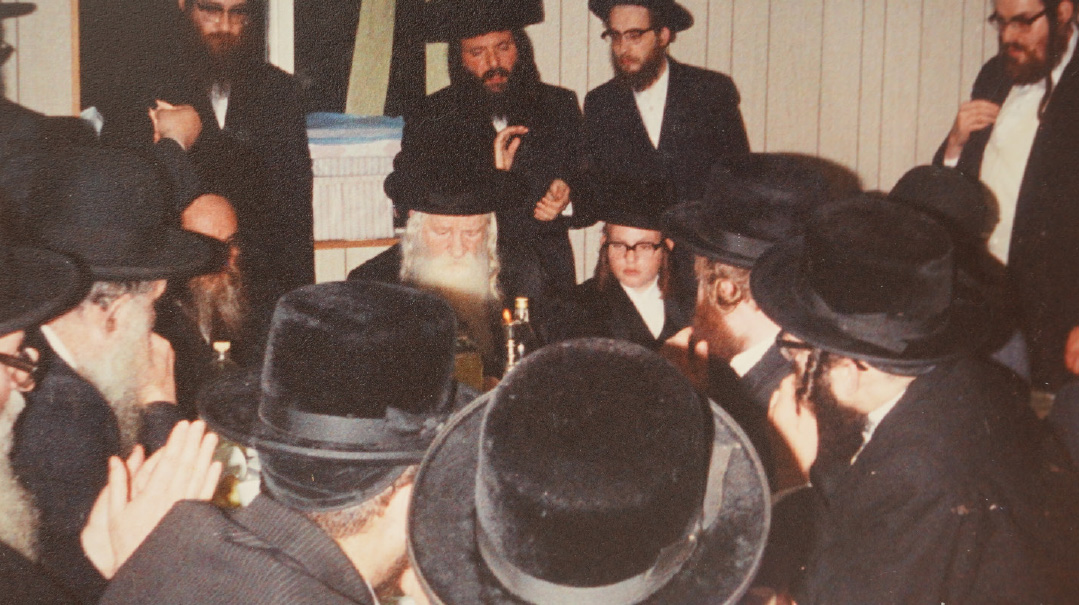
Night Watch
While Reb Yidele was the rebbe who didn’t want to be a rebbe, despite being the only surviving son of the Dzikover Rebbe murdered during the war, he was the one the Satmar Rebbe referred to when he commented, “…and the one who is truly suited to receive kvittlach doesn’t want to receive them.” Reb Yidele led a tish just twice a year, on Erev Yom Kippur and on Purim. Whoever was there joined him in an elevated realm.
“There was such emotion at those tishen,” Rav Taussig explains. “Such crying. Reb Yidele would eat a portion of fish on Erev Yom Kippur, but there were more tears than fish juice. The Tur writes of a tailor who went to buy fish for the mitzvah of eating on Erev Yom Kippur. There was only one fish left at the stall, and the local poritz had sent a servant to purchase fish too, but the Yid outbid him for the sake of the mitzvah. The poritz was infuriated, but the Yid’s actions caused a very positive tumult in Shamayim. With all this in mind, Reb Yidele would take each bite of fish ‘besheim kol Yisruel.’”
On Purim, talmidei chachamim and tzaddikim would gather around Reb Yidele. “Once, while Reb Yidele was holding the Mordechai V’Esther seudah,” remembers Rav Taussig, “his nephew Rav Shmuel Berezovsky, the current Slonimer Rebbe of Yerushalayim, asked Reb Yidele why he was crying so much. “Di zeist nisht, azah nideriggeh matzav — can’t you see? The Yidden were in such a lowly state that Esther had to marry the gentile king Achashveirosh.”
Rav Taussig’s sons were children in the days when their father put himself in the service of Reb Yidele. One night, the boys hid behind a closet to watch the tzaddik sleep. Just as he had said every night before lying down, Reb Yidele would awaken in the middle of the night a few times, and pronounce with great fervor and concentration, “Im zecharticha al yetzu’oi, be’ashmuros ehgeh bach —When I remember You on my bed, in the watches of the night, I contemplate You (Tehillim 63),” then go back to his rest.
“I was with him 365 days a year,” Rav Taussig comments. “Everything was tefillos and avodah. Everything.”
There is a famous yet simply-framed picture on the table, an amateur shot but perhaps the most well-known picture of Reb Yidele, wearing his tallis and tefillin, eyes shut, and arms raised in fiery prayer.
“He was a flam fier,” Rav Taussig testifies. “While davening, he did not know where he was in the world or who was standing near him. Birchos haTorah alone could take Reb Yidele half an hour, even on an ordinary day.”
AT one point, the holy Rav Aharon of Belz came to stay with a chassid named Reb Mendel Frankel, who lived in the same building as Reb Yidele. Reb Yidele wanted to go to the Rebbe to join the Shalosh Seudos tish. But since he’d already ended Shabbos and made Havdalah, he first washed for Melave Malkah so that he would be able to accept the shirayim of challah from the Rebbe. Seated at the tish, the Belzer Rebbe took a piece of challah and held it with both hands. “With this one can also be yotzei Melave Malkah,” the Rebbe commented, and passed it to Reb Yidele.
During the 1967 Six Day War, and again after Succos of 1973 when the country was in the throes of the Yom Kippur war, Reb Yidele left Eretz Yisrael. He did not have children and didn’t want to bother others to help him get to a shelter. He went to Lugano, Switzerland, where he was hosted by Reb Dovche Rubinfeld.
Years later, when Rav Taussig was visiting in Yerushalayim for Yom Tov after Reb Yidele’s passing, he was surprised to open the door to a very distinguished visitor. Rav Asher Arieli of the Mir had come to speak to him with a request to help out a certain talmid chacham. But first, Rav Asher asked Rav Taussig to tell him something from Reb Yidele.
“I told him that Reb Dovche Rubinfeld from Lugano, who had hosted Reb Yidele, once came to Yerushalayim. When he asked Reb Yidele to tell him about something interesting to see in the holy city, Reb Yidele sent him to see Rav Nochum Partzovitz, saying, “Go into the Mir yeshivah. If you want to see zos haTorah adam ki yamus ba’ohel — if you want to see someone ‘die’ for Torah — go and look at a Yid like Reb Nochum.” [Reb Nochum, the son-in-law of Rav Chaim Shmulevitz and father-in-law of Rav Asher Arieli, was very frail in his later years and learned with incredible self-sacrifice.]
Rav Arieli wanted to know when Reb Yidele had spent time with his legendary father-in-law. “Ven hubben zei farbrengt tzuzamen?”
It wasn’t a mystery to Rav Taussig. “Reb Yidele didn’t have to see Reb Nochum face to face to know what was happening with him — he ‘saw’ him, he knew.” And it wasn’t only with Reb Nochum. “When Reb Yidele travelled from Klausenburg to Lublin to see the famed Rav Shimale Zelichover, Reb Shimale was not present,” Rav Taussig adds. “Reb Yidele went home without actually seeing him, but he explained later that he had seen the bochurim of Yeshivas Lublin lein Krias Shema, and through that, he had ‘seen’ their rebbe. ‘Such a Krias Shema comes from Reb Shimale,’ Reb Yidele told me. ‘I saw him through his talmidim.’”

Rav Taussig was witness to a striking phenomenon: “Every time Reb Yidele would do a mitzvah, he would invoke the unity of Klal Yisrael, so that even if his own being was tainted by sin that would prevent the mitzvah from being accepted, being united with all Yidden would be a remedy”
Happy Hearts
The Rebbe was extremely frugal with himself, yet so generous with others. Although people brought him money for Yom Tov, he kept none of it, but gave it away to the poor. He ate chicken only on Shabbos, and washed for bread during the week. When Reb Yidele once asked Rav Taussig to buy a new light bulb, he stipulated that it should be only 25 watts — because he didn’t need it any brighter and it would be a waste. Yet for new mechutanim, he advised them to buy beautiful gifts for the kallah entering their family, giving the couple’s shalom bayis a bountiful start.
Reb Yidele did spend what he termed “kosher money” — shadchanus gelt, paid to him when he had arranged a shidduch. “He once told me that I should use shadchanus gelt to buy my arba minim, since the Maharil writes that those are truly pure earnings,” Rav Taussig says, “and I should therefore use them to purchase my mitzvah items from a pure source. That was the money which Reb Yidele permitted himself to use. Everything else he gave away,” Rav Taussig comments.
Once on the first night of Succos, Rav Taussig told his sons not to go home yet, but to stay around. “Stay up, I want to show you something,” he told them. They waited in the next room while Reb Yidele lay down to sleep in the succah. At around 11 p.m., Reb Yidele awoke and clapped his hands to call his loyal gabbai. “Ez is shoin di zman?” [“Is it time yet?”] The excitement and eagerness to shake the arba minim at dawn was so strong that he kept inquiring through the night if it was time.
Mitzvos were everything, and bein adam l’Makom never pushed away mitzvos between man and each other. Reb Yidele was very drawn to the holiness of the succah, and spent all of Yom Tov savoring his succah, until he kissed the walls in farewell on Simchas Torah eve. But one year in Yerushalayim, as Rav Taussig was accompanying Reb Yidele home from davening in the Dushinsky shul, expecting the rebbe to hurry to his beloved succah, Reb Yidele stopped and said, “Where are we running to? There is a tzubrochener Yid here…” and led the way to the home of a family who had recently lost their beloved son. He spoke and sang with this family for a few hours before going to fulfill his beloved mitzvah of sitting in his succah.
After all, as he explained to his talmidim, the Rambam writes that the focus of Yom Tov joy should be to gladden the hearts of almanos and yesomim.
As warm and compassionate as he was, Reb Yidele could be demanding. For example, Rav Taussig says, there was a young man who used to come to the tishen, but Reb Yidele knew he was not sufficiently involved in his own household — he didn’t make sure to help out enough. For this reason, the rebbe did not want to speak to him.
Another person came with a problem: he and his wife had a new baby daughter, and his wife wanted to give a certain name, ‘but it’s my turn, it’s my name.’ “Did you give birth?” Reb Yidele asked him. “You don’t say a word, you give whatever name she says.”
While Reb Yidele could be demanding of those closest to him, they knew that he cared deeply about their families’ welfare and their shalom bayis. He might have been elevated, but he really believed in ‘normal’ family life. Rav Taussig remembers the Rebbe’s reaction when he traveled abroad to accompany his widowed mother for medical treatment and left his wife for an extended period. “I was living with my young family in Eretz Yisrael when my mother’s illness required her to travel to Columbia-Presbyterian in New York for treatment,” Rav Taussig says. “I was away for ten weeks, leaving my wife with three small children. When I got back, I saw that Reb Yidele was wearing a kind of scarf which he made as a headache compress wrapped around his head. I inquired, and he told me, “I was wearing this the entire time you were away; I had a headache the entire time for your wife’s situation.”
When Rav Taussig was considering traveling abroad again for another reason, Reb Yidele told him in the strongest terms not to go, not to leave his family without their husband and father.
He had a special place in his heart for encouraging bereft families and helping them hold their lives together. “My own father was niftar young,” says Rav Taussig. “The Friday night after shivah had ended, after everything quieted down, Reb Yidele came up into the apartment to visit my mother and offer chizuk. When I would come to take him to the mikveh on a Friday, he would ask me when I had last visited my mother. On Friday nights he would pay visits to widows in order to encourage them.”
Reb Yidele’s day had no fixed schedule. It was filled with davening, learning, and writing Torah, and only when his energy was absolutely spent did Reb Yidele allow himself to lie down and sleep. Since his main rebbe was Rav Meir Arik, who was a talmid of the Maharsham, Reb Yidele knew all eight sections of the Maharsham. He constantly learned and quoted from the Chida, the Toldos Yaakov Yosef, and the Bnei Yissaschar, and he left behind manuscripts of glosses on these seforim, as well as on the Chazon Ish’s writings on the Tractate of Mikva’os. His own shiurim could be three to four hours long.
Sometimes there were glimpses of otherworldliness. Even those close to him did not know when Reb Yidele was fasting, which he did periodically. One Friday night, as Reb Yidele came home from shul, his lamp burned out. He sent his attendant to see if anything had happened — perhaps it was a sign of some calamity — but the attendant returned with no news. On Shabbos morning, the Dushinsky Rebbe informed Reb Yidele about the passing of the Tchebiner Rav. It had happened at the time when the lamp blew out, and Reb Yidele responded, “I knew.” He had a longtime connection to the Tchebiner Rav through Rav Meir Arik.
The first time Reb Yidele came to London was on 11 Teves 1983. Rav Taussig, who traveled with him, remembers that the Rebbe learned the sefer Chok L’Yisrael without stopping, throughout the flight. Although he was very weak, the doctors in Eretz Yisrael contended that the rebbe needed major surgery and that he should fly abroad. To avoid this, Reb Yidele placed himself under the medical care of the well-known Dr. Shloime Adler of Golders Green. His stay lasted 12 weeks, during which time the gedolim of Europe, such as the Manchester Rosh Yeshivah, Rav Yankele of Pshevorsk (Antwerp), and Rav Moshe Soloveitchik of Switzerland came to visit.
A year later, Reb Yidele returned to London, where he remained for four years — Dr. Adler continuing to treat his special patient with great care and precision until Reb Yidele’s passing in 1989. During those years, chassidim came from Canada, America, and across the world to bask in Reb Yidele’s light, although by that point he did not lead tishen and was barely able to speak.
The doors were not wide open — far from it. A limited number of people could come to see the ailing Rebbe, although those close to him had many opportunities to discuss Torah topics, and Reb Yidele did serve as sandek and laid tefillin on bar mitzvah boys.
One year, the Taussig family spent the Seder night at Reb Yidele’s table. “It was a night full of tears,” Rav Taussig remembers, “but still, the children were not forgotten, they were part of it — every child had a turn to say what he had prepared.”
Rabbi Shmuel Taussig, Reb Shloime’s son, shares what happened to him that Leil HaSeder. “I was a ten-year-old, reading a Yiddish-translated Hagaddah at the table, and I found a nice vort quoted there from the Sanzer Rebbe. On the words vatirbi, vatigdeli… ve’at eirom ve’eryah, I understood the Rebbe’s explanation to be something in my child’s mind like, ‘You think you are a big rebbe and have a big white beard, but really, ve’at eirom ve’eryah — you are nothing at all.’ I went over during Shulchan Oreich and whispered the vort quietly to Reb Yidele at the head of the table, and suddenly, the Rebbe started to cry bitterly. It was only much later that I realized what I had said.”
Fit for a Rebbe
When Reb Yidele became older and weaker, and didn’t have the energy to speak out the statements of unity during his avodah, he would just say, “Noam Elimelech, parshas Devarim,” where the idea is expressed.
Reb Yidele died at the age of 84 in 1989, leaving no will, heirs, or final instructions. He was buried in the Enfield Adath Yisroel Cemetery in London, and the gravesite, with an elaborate ohel erected over his tomb, is well-visited by those who want to tune into the elevated levels of Reb Yidele’s avodah, even as he spent his life projecting utter simplicity.
We look through the family bar mitzvah albums, with Reb Yidele present at the simchah, with him laying tefillin on a young bochur, and at a rare picture of him accompanied by Rav Taussig on a boat ride down the Thames River.
Then suddenly, the pictures come to an end. “When he was niftar, I felt that I had been thrown down from Heaven,” Rav Taussig says. “Walking down the local streets after the levayah, the entire world looked different, because I had lost everything. Everything.”
(Originally featured in Mishpacha, Issue 1014)
Oops! We could not locate your form.


